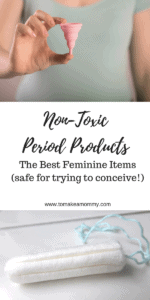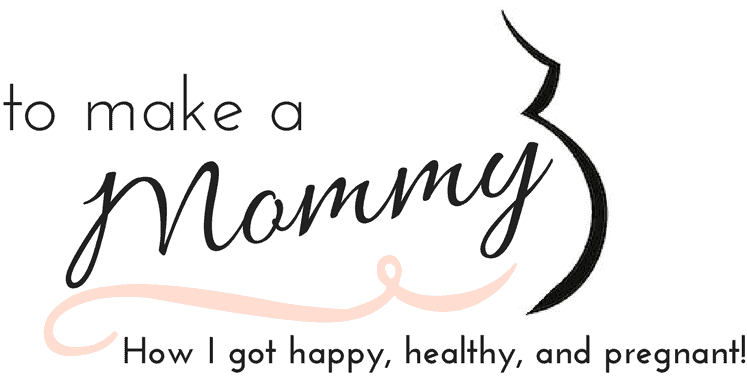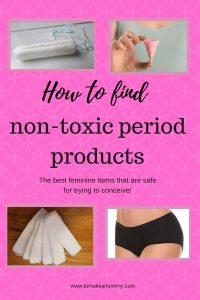*This post contains affiliate links which at no cost to you provide me with some small change to help keep this blog running! If you decide to buy something I recommend, please consider clicking through one of my links to help support this blog and my family! Thank you!

When I was first trying to reduce fertility-harming toxins from our house and lives, I started with the obvious- perfumes, scented body care products (deodorant, shampoos), and plastic containers that we ate or drank out of. But each week I would realize something else we used had toxic ingredients or chemicals that could be harming our fertility!
One item I realized I needed to stop using was conventional feminine pads and tampons. By “conventional” I mean the kind of brands you can buy at most stores. Unfortunately they have so many harmful ingredients- plastics, fragrance, dioxins, pesticides on the cotton, etc.! I switched completely over to organic cotton tampons and pads.
After a while I stopped using tampons altogether – not even the organic kinds. The reason was that I wanted the blood to flow easily out of my body. It was part of the way I visualized a healthy menstruation, and I didn’t like the idea of blood “stuck” in my body, even if it was just for a few hours. I’m not saying everyone has to do this- this was just my choice.
Since then (2014) I have learned about all sorts of different kinds of non-toxic feminine items, some of which are much more environmentally friendly than disposables!
In the post I’m going to talk about what the toxins in traditional feminine items are that you need to worry about, and what the non-toxic options are for you!
Potential Toxins in Traditional Pads and Tampons
Unfortunately there’s a high risk that conventional pads and tampons will have a great deal of fertility harming toxins. And, the skin down by your hoo-ha is some of the thinnest and most sensitive- thus some of the most at risk for toxins leaking into your body. Not to mention if you’re using a tampon, you’re actually putting those toxins up near where you would be growing a baby. You can see why I freaked out when I realized this and switched products!
Now, let’s take a look at each potential toxin. I’ll start with the worst offenders:
Fragrance/Phthalates– I remember growing up my mom taught me how to read the packages at the store to make sure the pads I was buying didn’t have fragrance. She was just worried about vaginal irritation. Now, of course we know a lot more about how the phthalates in fragrance get into our bloodstreams and reduce male and female fertility, increase the risk of miscarriage and pregnancy complications, and can lead to other health issues like cancer. Click here to read my full article on Phthalates & Fertility. Now, it is pretty much impossible to completely eliminate our exposure to phthalates, but I believe that is why it’s so important to reduce it as much as we possibly can.
Plastics– You know how those traditional pads have those fancy weave layers that kind of stick to your skin sometimes? They might be leaving trace amounts of tiny plastic materials on your skin. Icky! Unfortunately soft, pliable plastics are the most likely to include phthalates and/or BPA. So, we want all-organic cotton pads and tampons. Which, leads us to our next big problem toxin . . .
Pesticides– What? Pesticides in my tampon? Here’s the deal- cotton is one of the most heavily pesticide-d crops on the planet. Pesticides are related to delays in conceiving, harm to embryos, and spontaneous miscarriage. Now, while not all tampons or pads would have ALL pesticides, this was enough to convince me to go organic! Want more info? Here is a disturbing assessment done on the pesticides present in OB products.
Dioxin/Chlorine– So there’s a lot of fuss on the internet about tampons and pads laden with chlorine and dioxin. It turns out that a few decades ago the process they used to bleach them was pretty darn toxic- it used chlorine and resulted with a whole ton of harmful cancer-causing dioxin on the pads and tampons. Nowadays manufacturers no longer use that process, and dioxin levels have plummeted. It seems that there may still be some dioxin residue, but it is below concerning limits. Nonetheless, as endometriosis (an infertility condition which I have) is linked to dioxin exposure, I’d like to limit mine as much as possible, thank you very much!
Are you convinced it’s time to switch?
If you aren’t, how about this- many women swear that when they switch from conventional tampons and pads to a non-toxic alternative their period pain drops way down and their flow goes to a more regular level! Sounds great doesn’t it? So if you haven’t made the switch, do it today! Not only could it help you lower your exposure to toxins it could also help you have a better period!
Now, let’s talk about the alternatives!
Safe, Non-Toxic Feminine Items for your Period when Trying to Conceive!
Tampons, Pads, Menstrual Cups, and Period Panties
Organic Cotton Tampons
I used Seventh Generation & Natracare before I stopped using tampons. Please remember that skipping an applicator is a zillion times better for the environment! Please choose applicator free to lessen the impact on landfills. Just wash your hands before and after, ladies.
Seventh Generation Organic Cotton Tampons
Natracare Organic Cotton Tampons
Lola Organic Tampons/Pads/Liners/etc (they are a monthly delivery service)
Honest Company Organic Tampons
Organic Cotton Disposable Sanitary Pads
This is generally what I use even though they aren’t very eco-friendly. If you are determined to be more earth-friendly and reduce your waste footprint, scroll down for other options! I generally use Natracare pads!
Organic Cotton Reusable Cloth Sanitary Pads
A great, cost-effective, earth-friendly, and non-toxic option! You just have to be willing to wash them and make a one-time bigger investment. These are all organic options available on Amazon (there are plenty of non-organic options as well).
Lohanstore (these are pretty!)
Silicone Menstrual Cups
Many women swear by these and say that their periods have never been better after switching. They are extremely cost effective and great for the environment. Although I’m not worried about the medical grade silicone, I do sometimes worry about trace heavy metals from manufacturing. Tamara Rubin does a great job of testing all sorts of products for heavy metals and has found trace residue of cadmium on a few cups. She is always updating the information so check her latest posts before you purchase!
Also- many of these have multiple sizes, so if you have given birth and might need a larger cup, be sure to find that size before buying! Otherwise I have linked for pre-childbirth cup sizes!
I have a *** for the most popular on Amazon!
***Diva Cup (the most famous!)
***Blossom
***Lena
***Sckoon
***Athena
Period Panties
In general these are used as a back up to a cup, tampon, or pad, but sometimes if you just have spotting or a light flow you can use them as your only coverage! I’m only recommending organic ones, but there are a TON more on amazon that aren’t organic. Just search for “menstrual panties.”
Quicksilk *Not organic, but made with Bamboo instead of cotton
Thinx (not on amazon)
Oh!! And I don’t talk about them here, but for goodness sake never douche or use feminine wipes, wash or deodorant!!!! Those things are loaded with toxic fragrance/phthalates, and often have parabens and other harmful ingredients!!
*A note on sea sponges. My mother the hippy used to use sea sponges as tampons back in the day, and some women still do. But since we can’t guarantee that the ocean was clean where the sponges were harvested from, plus there are ethical issues with harvesting some sponges– I just can’t recommend this as an option.
Have another brand you love? Let me know!!
Want to get pregnant fast?
Love lists? Me too. Grab my 79 Things I did to transform my life and get pregnant in less than 3 months after 2 years of infertility and miscarriages! Totally free!
Anna Rapp is a fertility journalist and non-toxic living expert. When Anna Rapp was struggling with infertility and recurrent early miscarriage, she was diagnosed with diminished ovarian reserve, High FSH, low AMH, low follicle count, endometriosis, and an MTHFR mutation. Despite being told donor eggs were her only solution, Anna used her graduate training in research methods and analysis to read everything she could find on fertility and egg health. Ultimately, she lowered her FSH and got pregnant naturally (twice). She blogs about how she did it and encourages her readers to take charge of their fertility journey and get happy, healthy, and pregnant!




Thinx FOR THE WIN! I love these so much, especially as backup for my menstrual cup. Softcups have a special place in my heart (I’ve used them for years, and they helped me get pregnant!) so I don’t even want to look at the chemicals that might me in them. It’s good to know the other menstrual cups are made of silicone and not plastic! I might consider a change 🙂
Awesome!! I totally need to get on my game and try these!!! Think about a change to silicone for sure 🙂